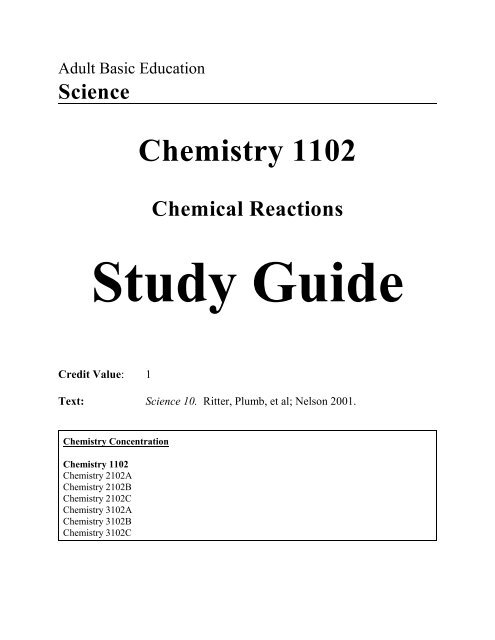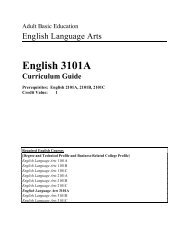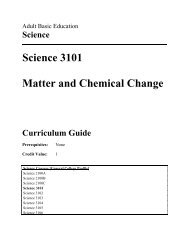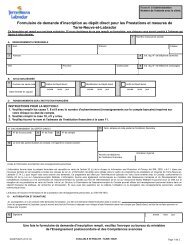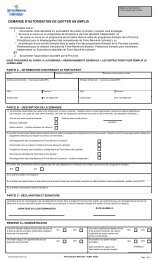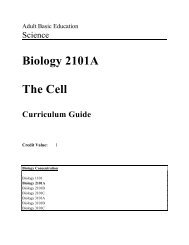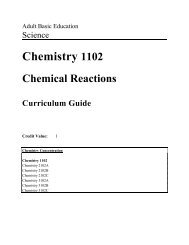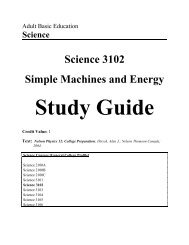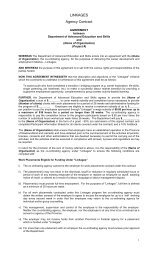Chemistry 1102 Study Guide 2005-06
Chemistry 1102 Study Guide 2005-06
Chemistry 1102 Study Guide 2005-06
You also want an ePaper? Increase the reach of your titles
YUMPU automatically turns print PDFs into web optimized ePapers that Google loves.
Adult Basic Education<br />
Science<br />
<strong>Chemistry</strong> <strong>1102</strong><br />
Chemical Reactions<br />
<strong>Study</strong> <strong>Guide</strong><br />
Credit Value: 1<br />
Text: Science 10. Ritter, Plumb, et al; Nelson 2001.<br />
<strong>Chemistry</strong> Concentration<br />
<strong>Chemistry</strong> <strong>1102</strong><br />
<strong>Chemistry</strong> 2102A<br />
<strong>Chemistry</strong> 2102B<br />
<strong>Chemistry</strong> 2102C<br />
<strong>Chemistry</strong> 3102A<br />
<strong>Chemistry</strong> 3102B<br />
<strong>Chemistry</strong> 3102C
Table of Contents<br />
To the Student ................................................................v<br />
Introduction to <strong>Chemistry</strong> <strong>1102</strong> .............................................v<br />
Use of Science <strong>Study</strong> <strong>Guide</strong>s .............................................. vi<br />
Recommended Evaluation ............................................... vii<br />
Unit 1 - Investigating Chemical Reactions ..................................... Page 1<br />
Unit 2 - Formula Writing .................................................. Page 3<br />
Unit 3 - Equation Writing .................................................. Page 6<br />
Unit 4 - Introduction to Acids and Bases...................................... Page 10<br />
Appendix A ............................................................ Page 14
To the Student<br />
I. Introduction to <strong>Chemistry</strong> <strong>1102</strong><br />
This is the first course in the ‘<strong>Chemistry</strong> Concentration’ in the Adult Basic Education<br />
program. If you have not recently completed grade 9 in school or Level II in ABE, you<br />
may need to spend some time at the beginning of this course learning about atomic<br />
structure and the periodic table.<br />
In this course you will learn about naming and writing formulas for ionic and molecular<br />
compounds. You will also learn to write chemical equations. You will be expected to<br />
know these topics very well in order to have the necessary foundation to build upon as<br />
you continue in the <strong>Chemistry</strong> concentration in ABE.<br />
It is very important to note that this course is a pre-requisite to all the other ABE<br />
<strong>Chemistry</strong> courses.<br />
There are 2 required labs for this course. Let your instructor know in advance that you are<br />
getting close to being ready to do the labs. The labs require a written report that will be<br />
used as part of your final mark for the course. In addition, there is one assignment that<br />
you will be asked to submit. This will also be used as part of your evaluation for the<br />
course.<br />
You will need lots of practice as you work through the material in this course. There are<br />
several worksheets in the Appendix that you should complete. See your instructor for the<br />
answers. Your teacher may also provide you with additional worksheets.<br />
The text for this course is Science 10; Ritter, Plumb, et al; Nelson, 2001.<br />
<strong>Study</strong> <strong>Guide</strong> v<br />
<strong>Chemistry</strong> <strong>1102</strong>
To the Student<br />
II.<br />
Use of Science <strong>Study</strong> <strong>Guide</strong>s<br />
Before beginning this course, ensure you have the text and any other resources needed<br />
(see the information in the Introduction to this course for specifics).<br />
As you work through the <strong>Study</strong> <strong>Guide</strong>, you will see that it is divided according to the<br />
Units listed in the Table of Contents. When you open a unit it will have the following<br />
components:<br />
Reading for this Unit:<br />
Here you will find the chapters, sections and pages of the text you will use to cover the material for this unit. Skim<br />
the sections of the textbook, look at the titles of the sections, scan the figures and read any material in the margins.<br />
Once you have this overview of the unit, you are ready to begin. Do not be intimidated by the content. You will<br />
work through the text, section by section, gaining knowledge and understanding of the material as you go.<br />
References and Notes<br />
This left hand column guides you through the<br />
material to read from the text. Read any<br />
highlighted notes that follow the reading<br />
instructions. The symbols || direct you to<br />
the questions that you should complete when<br />
finished a reading assignment..<br />
Work to Submit<br />
You come across three (3) headings in this right hand column.<br />
Writing:<br />
This section comprises your notes for the unit.<br />
Here you will find either written questions or<br />
references to specific questions or problems<br />
from your text. You may want to write out<br />
each question followed by the answer. This<br />
material should be checked by your instructor<br />
before moving on to the next unit.<br />
Mathematical problems should have their<br />
solutions checked as you go.<br />
Laboratory:<br />
Assignment:<br />
This section indicates if there is a Core Lab<br />
that should be completed for the unit. Let the<br />
instructor know in advance that you will be<br />
ready for the lab. A lab report should be<br />
submitted for each Core Lab. Your<br />
instructor will provide guidelines as to how<br />
s/he wants the report written.<br />
This section indicates if there is an assignment<br />
that should be completed for the Unit. The<br />
information in the “References and Notes”<br />
column will indicate how you obtain the<br />
assignment. These assignments frequently<br />
relate the science content to technology,<br />
society and the environment.<br />
<strong>Study</strong> <strong>Guide</strong> vi<br />
<strong>Chemistry</strong> <strong>1102</strong>
To the Student<br />
III.<br />
Recommended Evaluation<br />
Written Notes 10%<br />
Labs/Assignments 20%<br />
Test(s) 20%<br />
Final Exam (entire course) 50%<br />
100%<br />
The overall pass mark for the course is 50%.<br />
<strong>Study</strong> <strong>Guide</strong> vii<br />
<strong>Chemistry</strong> <strong>1102</strong>
Unit 1 - Investigating Chemical Reactions<br />
To fulfill the objectives of this unit, students should complete the following:<br />
Reading for this unit: Science 10<br />
Chapter 5: Introduction: pages 170-171<br />
Section 5.1: pages 172-174<br />
Investigation 5.3: pages 180-182<br />
Handout 1: “WHMIS Activity”: Appendix A<br />
References and Notes<br />
Work to Submit<br />
Referring to pages 170-174, write<br />
answers for questions 1.1 - 1.6.||<br />
Writing:<br />
1.1 Define:<br />
a) chemistry<br />
b) matter.<br />
1.2 Define and give two (2) examples of each of<br />
the following:<br />
a) pure substances<br />
b) element<br />
c) compound<br />
d) physical property<br />
e) chemical property<br />
f) chemical change<br />
g) reactant<br />
h) product<br />
1.3 What are five (5) clues that a chemical change<br />
has occurred?<br />
1.4 What is a chemical test and what is its<br />
purpose?<br />
<strong>Study</strong> <strong>Guide</strong> Page 1<br />
<strong>Chemistry</strong> <strong>1102</strong>
Unit 1 - Investigating Chemical Reactions<br />
References and Notes<br />
Work to Submit<br />
Writing:<br />
1.5 Briefly describe the chemical tests for:<br />
a) oxygen (O 2)<br />
b) hydrogen (H 2)<br />
c) carbon dioxide (CO 2)<br />
d) water vapor (H O)<br />
1.6 Complete Questions 1-2 and 4-5, on page<br />
175.<br />
2<br />
Before you go into the lab, you should<br />
complete the Assignment ||<br />
Assignment:<br />
1.7 Complete the “WHMIS Activity” found in<br />
Appendix A of this <strong>Study</strong> <strong>Guide</strong>.<br />
Note: Refer to “Safety Conventions<br />
and Symbols”, page 658, and the<br />
MSDS sheet in Appendix A to help you<br />
with the assignment.<br />
Laboratory:<br />
Referring to pages 180-182, complete<br />
the Laboratory Investigation.||<br />
1.8 Work carefully through the 5.3 Investigation,<br />
“Testing Properties of Substances”. Prepare<br />
your lab report as outlined by your instructor.<br />
See your instructor to discuss any<br />
additional work that you should<br />
complete for this unit.<br />
<strong>Study</strong> <strong>Guide</strong> Page 2<br />
<strong>Chemistry</strong> <strong>1102</strong>
Unit 2 - Formula Writing<br />
To fulfill the objectives of this unit, students should complete the following:<br />
Reading for this unit: Science 10<br />
Chapter 5: Section 5.5: pages 184-187<br />
Section 5.6: pages 188-189<br />
Section 5.8: pages 192-195<br />
Section 5.9: pages 196-198<br />
Handout 2: “Introduction to IUPAC”: Appendix A<br />
Handout 3: “IUPAC Naming of Compounds and Writing<br />
Formulas”: Appendix A<br />
Handout 4: “Naming Ionic Hydrates”: Appendix A<br />
References and Notes<br />
Referring to pages 184-187, write<br />
answers for questions 2.1 - 2.7 ||<br />
Work to Submit<br />
Writing:<br />
2.1 Define and give two examples of electrolyte<br />
and nonelectrolyte.<br />
2.2 Define periodic table<br />
NOTE:<br />
Read carefully “Did You Know?” on<br />
pages 186 and 187 to make sure you<br />
are familiar with the terms:<br />
valence shell<br />
valence electron<br />
cation<br />
anion<br />
2.3 a) Define chemical families.<br />
b) Name the chemical family identified<br />
by each of the following group<br />
numbers:<br />
Group 1<br />
Group 2<br />
Group 17<br />
Group 18<br />
2.4 Name and describe the three subatomic<br />
particles (include the charge on each).<br />
<strong>Study</strong> <strong>Guide</strong> Page 3<br />
<strong>Chemistry</strong> <strong>1102</strong>
Unit 2 - Formula Writing<br />
References and Notes<br />
Note:<br />
<strong>Study</strong> Handout 2, “Introduction to<br />
IUPAC” (found in Appendix A) before<br />
you go any further. Make sure you<br />
are familiar with the following terms<br />
and that you can use them as you<br />
work through the remainder of this<br />
course:<br />
molecule<br />
compound<br />
molecular element (diatomic<br />
molecule)<br />
molecular formula<br />
empirical formula<br />
Referring to pages 188-189, write<br />
answers for questions 2.8 and 2.9 ||<br />
Note:<br />
Molecular compounds are made up of<br />
non-metal atoms only.<br />
Read pages 192-195 carefully before<br />
writing answers for questions 2.10<br />
and 2.11 ||<br />
Work to Submit<br />
Writing:<br />
2.5 Define ion and explain how ions are formed.<br />
2.6 When an element forms a negative ion, what<br />
happens to its name?<br />
2.7 Complete questions 2-7 in “Understanding<br />
Concepts”, page 187.<br />
2.8 Explain the difference between the types of<br />
elements present in ionic and molecular<br />
compounds.<br />
2.9 Complete questions 1-5 in “Understanding<br />
Concepts”, page 189.<br />
2.10 Define valence.<br />
2.11 Complete questions 1-9 in “Understanding<br />
Concepts”, page 195.<br />
Read pages 196-198 carefully before<br />
answering question 2.12 - 2.13 ||<br />
Note:<br />
Remember, if there is more than one<br />
polyatomic ion, use brackets.<br />
Mg(NO 3) 2is correct. MgNO 32is<br />
incorrect.<br />
2.12 Complete questions 1-4, 6 and 7 in<br />
“Understanding Concepts”, page 198.<br />
2.13 What do you think is the formula and charge<br />
of the<br />
a) chlorite ion<br />
b) phosphite ion.<br />
<strong>Study</strong> <strong>Guide</strong> Page 4<br />
<strong>Chemistry</strong> <strong>1102</strong>
Unit 2 - Formula Writing<br />
References and Notes<br />
Read carefully through Handout 4,<br />
“Naming Ionic Hydrates” before you<br />
complete 2.14 and 2.15 ||<br />
Work to Submit<br />
Writing:<br />
2.14 Define hydrate<br />
2.15 Complete the worksheet, “Naming Ionic<br />
Hydrates” in Appendix A.<br />
Read pages 201-204 carefully before<br />
completing questions 2.16 - 2.18 ||<br />
2.16 Complete questions 1-6 in “Understanding<br />
Concepts”, page 204.<br />
2.17 Give the common names of each of the<br />
following compounds:<br />
a) H2O<br />
b) NH 3<br />
c) CH 4<br />
d) H O<br />
2 2<br />
Note: You will find Handout 3,<br />
“IUPAC Naming of Compounds and<br />
Writing Formulas”, in Appendix A of<br />
this study guide. It provides a<br />
summary of what you should know<br />
about naming compounds.<br />
<strong>Study</strong> Handout 3 and make sure you<br />
understand it before completing 2.19<br />
||<br />
2.18 Write the formulas for:<br />
a) nitrogen<br />
b) oxygen<br />
c) fluorine<br />
d) bromine<br />
e) iodine<br />
2.19 Complete the worksheets included with<br />
“IUPAC Naming of Compounds and Writing<br />
Formulas”.<br />
See your instructor to discuss any<br />
additional work that you should<br />
complete for this unit.<br />
<strong>Study</strong> <strong>Guide</strong> Page 5<br />
<strong>Chemistry</strong> <strong>1102</strong>
Unit 3 -Equation Writing<br />
To fulfill the objectives of this unit, students should complete the following:<br />
Reading for this unit: Science 10<br />
Chapter 6: Introduction: pages 216-217<br />
Section 6.1: pages 218-219<br />
Section 6.3: pages 222-223<br />
Section 6.5: pages 226-229<br />
Section 6.6: pages 230-232<br />
Section 6.7: pages 233-235<br />
Section 6.10: pages 240-241<br />
References and Notes<br />
Read pages 218-219 carefully before<br />
completing questions 3.1 - 3.3 ||<br />
Work to Submit<br />
Writing:<br />
3.1 Define word equation.<br />
3.2 Complete the activity on page 219.<br />
Referring to pages 222-223, follow the<br />
instructions in 3.4 ||<br />
3.3 Complete questions 1-4 in “Understanding<br />
Concepts”, page 219.<br />
3.4 Complete questions 1 and 5 in<br />
“Understanding Concepts”, page 223.<br />
<strong>Study</strong> <strong>Guide</strong> Page 6<br />
<strong>Chemistry</strong> <strong>1102</strong>
Unit 3 -Equation Writing<br />
References and Notes<br />
Read pages 226-229 carefully before<br />
completing questions 3.5 and 3.6 ||<br />
Work to Submit<br />
Writing:<br />
3.5 Write definitions for each of the following:<br />
a) skeleton equation<br />
b) balanced chemical equation<br />
c) coefficient<br />
3.6 Complete questions 1-5 in “Understanding<br />
Concepts”, page 229.<br />
Note:<br />
Notice that the following subscripts<br />
are used to indicate the state of each<br />
substance:<br />
(s) for a solid;<br />
(l) for a liquid:<br />
(g)<br />
(aq)<br />
for a gas:<br />
for an aqueous solution<br />
(dissolved in water)<br />
<strong>Study</strong> <strong>Guide</strong> Page 7<br />
<strong>Chemistry</strong> <strong>1102</strong>
Unit 3 -Equation Writing<br />
References and Notes<br />
Read pages 230 - 232 carefully before<br />
completing questions 3.7 and 3.8 ||<br />
Work to Submit<br />
Writing:<br />
3.7 a) Define combustion.<br />
b) Explain what is meant by incomplete<br />
combustion.<br />
3.8 Complete questions 3 - 6 in “Understanding<br />
Concepts”, page 232.<br />
Read pages 233 - 235 carefully before<br />
completing questions 3.9 - 3.11 ||<br />
3.9 a) What are synthesis reactions?<br />
b) What is the general formula for<br />
synthesis reactions?<br />
3.10 a) What are decomposition reactions?<br />
b) What is the general formula for<br />
decomposition reactions?<br />
3.11 Complete questions 1 - 5 in “Understanding<br />
Concepts”, page 235.<br />
Referring to pages 236 -239 ,<br />
complete one of the Investigations<br />
||<br />
Laboratory:<br />
3.12 Work carefully through Investigation<br />
6.8 ,“Putting Things Together”, or 6.9 ,“Taking<br />
Things Apart”. Prepare your lab report as outlined<br />
by your instructor.<br />
<strong>Study</strong> <strong>Guide</strong> Page 8<br />
<strong>Chemistry</strong> <strong>1102</strong>
Unit 3 -Equation Writing<br />
References and Notes<br />
Read pages 240 - 241 carefully before<br />
completing questions 3.13 - 3.15 ||<br />
Note:<br />
A precipitate is a solid formed from<br />
two solutions. It will not dissolve in<br />
water.<br />
Work to Submit<br />
Writing:<br />
3.13 a) What are single displacement<br />
reactions?<br />
b) What are the general formulas for<br />
single displacement reactions?<br />
3.14 How do you decide which element is replaced<br />
in a single displacement reaction?<br />
3.15 a) What are double displacement<br />
reactions?<br />
b) What is the general formula for<br />
double displacement reactions?<br />
For review of the topics covered in<br />
Unit 3, complete questions 3.16 and<br />
3.17 ||<br />
See your instructor to discuss any<br />
additional work that you should<br />
complete for this unit.<br />
3.16 Complete questions 1 - 6 in “Understanding<br />
Concepts”, page 247.<br />
3.17 Complete questions 1 - 6 and 17 in the<br />
Chapter 6 Review, “Understanding<br />
Concepts”, page 252 - 253.<br />
<strong>Study</strong> <strong>Guide</strong> Page 9<br />
<strong>Chemistry</strong> <strong>1102</strong>
Unit 4 - Introduction to Acids and Bases<br />
To fulfill the objectives of this unit, students should complete the following:<br />
Reading for this unit: Science 10<br />
Chapter 8: Introduction: pages 288 - 289<br />
Section 8.2: pages 293 - 295<br />
Section 8.3: pages 296 - 299<br />
Investigation 8.9: page 314<br />
Section 8.10: pages 317 - 319<br />
Handout 5: “Naming Acids”: Appendix A<br />
References and Notes<br />
Referring to pages 293 - 295 and the<br />
glossary, write answers for questions<br />
4.1 - 4.3 ||<br />
Note:<br />
In order for an acid to have acidic<br />
properties, it must be dissolved in<br />
water. To indicate that it is dissolved<br />
in water, the formula of an acid must<br />
be followed by the (aq) subscript.<br />
Work to Submit<br />
Writing:<br />
4.1 Copy and complete the following statements:<br />
a) can be defined as substances<br />
+<br />
that release Hydrogen (H ) ions in water.<br />
b) can be defined as ionic<br />
compounds that release the hydroxide ion<br />
-<br />
(OH ) in water.<br />
4.2 a) Use the glossary to write definitions<br />
for acids and bases.<br />
b) List five (5) properties of acids.<br />
c) List four (4) properties of bases.<br />
4.3 Complete questions 1, 3, and 4 in<br />
“Understanding Concepts”, page 295.<br />
<strong>Study</strong> <strong>Guide</strong> Page 10<br />
<strong>Chemistry</strong> <strong>1102</strong>
Unit 4 - Introduction to Acids and Bases<br />
References and Notes<br />
<strong>Study</strong> Handout 5, “Naming Acids”,<br />
found in Appendix A and answer 4.4<br />
||<br />
Referring to page 296, write answers<br />
for questions 4.5 and 4.6 ||<br />
Referring to pages 314 - 319, write<br />
answers for questions 4.7 - 4.9 ||<br />
Note:<br />
The general equation for a<br />
neutralization reaction is:<br />
ACID + BASE SALT + WATER<br />
HA + BOH BA + HOH (H O)<br />
A salt does not necessarily mean<br />
sodium chloride.<br />
2<br />
Work to Submit<br />
Writing:<br />
4.4 Complete the worksheet , “Naming Acids”.<br />
(Appendix A)<br />
4.5 Define pH scale.<br />
4.6 Complete questions 1-7 in “Understanding<br />
Concepts”, page 299.<br />
4.7 a) Define neutralization (include the<br />
general products of a neutralization<br />
reaction).<br />
b) What category of reactions is<br />
neutralization?<br />
c) Describe two (2) examples of<br />
neutralization reactions.<br />
4.8 Define salt.<br />
4.9 Complete questions 3 and 4 in<br />
“Understanding Concepts”, page 319.<br />
See your instructor to discuss any<br />
additional work that you should<br />
complete for this unit.<br />
<strong>Study</strong> <strong>Guide</strong> Page 11<br />
<strong>Chemistry</strong> <strong>1102</strong>
Appendix A
Handout 1 -“ WHMIS Activity”<br />
1. What does WHMIS stand for?<br />
2. What is the purpose of using WHMIS symbols?<br />
3. What does MSDS stand for?<br />
4. Identify the nine sections of the MSDS.<br />
I<br />
II<br />
III<br />
IV<br />
VI<br />
VII<br />
VIII<br />
IX<br />
V<br />
5. What is the name and chemical formula of the chemical?<br />
6. What would happen if you were overexposed to the chemical?<br />
7. When you are using this chemical, how would you protect yourself?<br />
8. How must this chemical be stored?<br />
<strong>Study</strong> <strong>Guide</strong> Page 15<br />
<strong>Chemistry</strong> <strong>1102</strong>
MSDS Sample Sheet<br />
<strong>Study</strong> <strong>Guide</strong> Page 16<br />
<strong>Chemistry</strong> <strong>1102</strong>
Handout 2 - “Introduction to IUPAC”<br />
Today most compounds are known by their IUPAC names. IUPAC stands for International<br />
Union of Pure and Applied <strong>Chemistry</strong>. This organization has determined a set of rules to be<br />
used for naming chemicals. Its purpose is to set international guidelines so that all scientists<br />
follow the same rules.<br />
Before you start naming compounds and writing formulas, you need to make sure you understand<br />
the following:<br />
Molecules are combinations of two or more elements.<br />
*A molecular element has all atoms the same.<br />
For example, oxygen gas is a molecule composed of 2 atoms of oxygen. It is<br />
called a diatomic molecule (because it has 2 atoms).<br />
Table of Diatomic Molecules<br />
oxygen O 2<br />
hydrogen H 2<br />
nitrogen N 2<br />
fluorine F 2<br />
chlorine Cl 2<br />
bromine Br 2<br />
iodine I 2<br />
<strong>Study</strong> <strong>Guide</strong> Page 17<br />
<strong>Chemistry</strong> <strong>1102</strong>
Handout 2 - “Introduction to IUPAC” ( continued )<br />
A compound is a molecule that contains 2 or more different types of atoms or ions.<br />
For example, water (H2O) is a compound because it contains both hydrogen and oxygen.<br />
The formula for water, H2O, is a combination of symbols and subscripts.<br />
H and O are the symbols for hydrogen and oxygen.<br />
The number 2 is the subscript. It indicates that there are 2 atoms of hydrogen in a<br />
molecule of water.<br />
A molecular formula is a chemical formula that indicates the number and type of atoms in one<br />
molecule (i.e. the actual number of atoms of each type in the compound).<br />
An empirical formula is the simplest whole number ratio of atoms in the compound.<br />
For example, hydrogen peroxide:<br />
The molecular formula is H2O2<br />
The empirical formula is HO (lowest ratio is 1:1)<br />
Note: In some cases the molecular formula and the empirical formula are the same.<br />
<strong>Study</strong> <strong>Guide</strong> Page 18<br />
<strong>Chemistry</strong> <strong>1102</strong>
Handout 3 - “IUPAC Naming of Compounds and Writing Formulas”<br />
Rules for Naming Binary Ionic Compounds (simple/multivalent)<br />
1. Name the cation (+) by writing the full name of the metal.<br />
2. Check the attached partial periodic table to see if it is a multivalent species (has more than<br />
one possible ionic charge).<br />
If it has only one ionic charge, proceed to step 3.<br />
If it has more than 1 possible ionic charge, determine the charge of the anion and pick<br />
the metal ion that will result in a net charge of zero. Indicate the identity of the metal<br />
ion with roman numerals.<br />
3. Name the anion (-) by shortening the name of the atom and adding the -ide ending.<br />
Examples: NaCl<br />
K2O<br />
sodium chloride<br />
potassium oxide<br />
CaF 2 calcium fluoride<br />
SnCl 4 tin(IV) chloride<br />
<strong>Study</strong> <strong>Guide</strong> Page 19<br />
<strong>Chemistry</strong> <strong>1102</strong>
PARTIAL PERIODIC TABLE OF THE ELEMENTS<br />
1 18<br />
2 13 14 15 16 17<br />
3 4 5 6 7 8 9 10 11 12<br />
Cr 2+ Mn 2+ Fe 2+ Co 2+ Cu +<br />
Cr 3+ Mn 3+ Fe 3+ Co 3+<br />
Cu 2+ Sn 2+<br />
Sn 4+<br />
Pb 2+<br />
Pb 4+<br />
<strong>Study</strong> <strong>Guide</strong> Page 20<br />
<strong>Chemistry</strong> <strong>1102</strong>
Handout 3 - “IUPAC Naming of Compounds and Writing Formulas”<br />
Rules for Writing Formulas for Binary Ionic Compounds<br />
1. Write the symbols of the ions involved.<br />
2. Determine the charges of the ions.<br />
For the cation (positive ion):<br />
If there is no roman numeral after the name of the metal, the ion has only one ionic<br />
charge.<br />
If there is a roman numeral after the name of the metal, the ion has more than 1<br />
possible ionic charge, and you must use the roman numeral to determine the charge.<br />
For the anion (negative ion):<br />
There is only one possible charge (recall group number).<br />
3. Determine the lowest whole number ratio of ions that will give a net charge of zero. This<br />
number (if something other than 1) is written as a subscript after the symbol for the ion.<br />
4. Write the formula removing all charges.<br />
Examples: Potassium bromide<br />
Calcium phosphide<br />
KBr<br />
Ca P<br />
3 2<br />
Iron(II) chloride FeCl 2<br />
Copper(I) chloride<br />
CuCl<br />
<strong>Study</strong> <strong>Guide</strong> Page 21<br />
<strong>Chemistry</strong> <strong>1102</strong>
Handout 3 - “IUPAC Naming of Compounds and Writing Formulas”<br />
1. Write the name of the first element in full.<br />
Rules for Naming Molecular Compounds<br />
2. Shorten the name of the second element and add the ide ending.<br />
3. Use prefixes to indicate the number of atoms of each element in the molecular formula.<br />
4. The prefix mono on the first name is optional.<br />
Examples:<br />
CCl 4 Carbon tetrachloride<br />
SiO 2 Silicon dioxide<br />
CO<br />
Carbon Monoxide<br />
<strong>Study</strong> <strong>Guide</strong> Page 22<br />
<strong>Chemistry</strong> <strong>1102</strong>
Handout 3 - “IUPAC Naming of Compounds and Writing Formulas”<br />
Rules for Writing Molecular Formulas<br />
1. Write the symbols for each element in the compound.<br />
2. Use the prefix to determine the number of atoms of each element in the formula and write<br />
the appropriate number as a subscript to the right of the element’s symbol.<br />
3. If an element lacks a prefix, assume that there is just one atom of that element. It is not<br />
necessary to write the numerical subscript 1, since it is implied.<br />
Examples:<br />
Diboron hexahydride B2H6<br />
Nitrogen trioxide NO 3<br />
<strong>Study</strong> <strong>Guide</strong> Page 23<br />
<strong>Chemistry</strong> <strong>1102</strong>
Handout 3 - “IUPAC Naming of Compounds and Writing Formulas”<br />
Worksheet 1<br />
<strong>Study</strong> <strong>Guide</strong> Page 24<br />
<strong>Chemistry</strong> <strong>1102</strong>
Handout 3 - “IUPAC Naming of Compounds and Writing Formulas”<br />
Worksheet 2<br />
<strong>Study</strong> <strong>Guide</strong> Page 25<br />
<strong>Chemistry</strong> <strong>1102</strong>
<strong>Study</strong> <strong>Guide</strong> Page 26<br />
<strong>Chemistry</strong> <strong>1102</strong>
Worksheet 3<br />
<strong>Study</strong> <strong>Guide</strong> Page 27<br />
<strong>Chemistry</strong> <strong>1102</strong>
<strong>Study</strong> <strong>Guide</strong> Page 28<br />
<strong>Chemistry</strong> <strong>1102</strong>
Worksheet 4<br />
<strong>Study</strong> <strong>Guide</strong> Page 29<br />
<strong>Chemistry</strong> <strong>1102</strong>
<strong>Study</strong> <strong>Guide</strong> Page 30<br />
<strong>Chemistry</strong> <strong>1102</strong>
Worksheet 5<br />
<strong>Study</strong> <strong>Guide</strong> Page 31<br />
<strong>Chemistry</strong> <strong>1102</strong>
<strong>Study</strong> <strong>Guide</strong> Page 32<br />
<strong>Chemistry</strong> <strong>1102</strong>
Handout 4 - “Naming Ionic Hydrates”<br />
An ionic hydrate is a compound that has water associated with it. Water is part of its crystalline<br />
structure.<br />
The name of an ionic hydrate can be distinguished from the names of other ionic compounds by<br />
the presence of the term hydrate with a prefix indicating the number of water molecules.<br />
For example:<br />
The IUPAC formula for calcium chloride dihydrate is CaCl 2 2H 2 O.<br />
The IUPAC formula for calcium magnesium sulfate heptahydrate is MgSO 4 7H 2 O.<br />
(Note the raised dot in front of the water molecules.)<br />
In order to convert IUPAC names for ionic hydrates into chemical formulas, you will need to<br />
know the prefixes listed below:<br />
mono 1<br />
di 2<br />
tri 3<br />
tetra 4<br />
penta 5<br />
hexa 6<br />
hepta 7<br />
octa 8<br />
nona 9<br />
deca 10<br />
<strong>Study</strong> <strong>Guide</strong> Page 33<br />
<strong>Chemistry</strong> <strong>1102</strong>
Handout 4 - “Naming Ionic Hydrates”<br />
Worksheet<br />
<strong>Study</strong> <strong>Guide</strong> Page 34<br />
<strong>Chemistry</strong> <strong>1102</strong>
Handout 5 - “Naming Acids”<br />
For this course, when you are given a chemical formula for a hydrogen compound that has<br />
the (aq) state of matter subscript, you name it as an acid.<br />
Rules for naming acids:<br />
1. If the anion does not contain oxygen, the acid is named with the prefix hydro- and the suffix<br />
-ic attached to the root name for the element.<br />
Example: HCl<br />
HCN<br />
(aq)<br />
HS 2 (aq)<br />
(aq)<br />
hydrochloric acid<br />
hydrocyanic acid<br />
hydrosulfuric acid<br />
2. If the anion contains oxygen, check the ending if the anion.<br />
If the anion has the -ite ending, the suffix -ous is used.<br />
Example:<br />
2-<br />
HSO contains the sulfite (SO ) ion and is named sulfurous acid .<br />
2 3 (aq)<br />
3<br />
If the anion has the -ate endind, the suffix -ic is used..<br />
Example:<br />
2-<br />
HSO contains the sulfate (SO ) ion and is named sulfuric acid .<br />
2 4 (aq)<br />
4<br />
<strong>Study</strong> <strong>Guide</strong> Page 35<br />
<strong>Chemistry</strong> <strong>1102</strong>
Handout 5 - “Naming Acids”<br />
Worksheet<br />
<strong>Study</strong> <strong>Guide</strong> Page 36<br />
<strong>Chemistry</strong> <strong>1102</strong>
<strong>Study</strong> <strong>Guide</strong> Page 37<br />
<strong>Chemistry</strong> <strong>1102</strong>
<strong>Study</strong> <strong>Guide</strong> Page 38<br />
<strong>Chemistry</strong> <strong>1102</strong>


